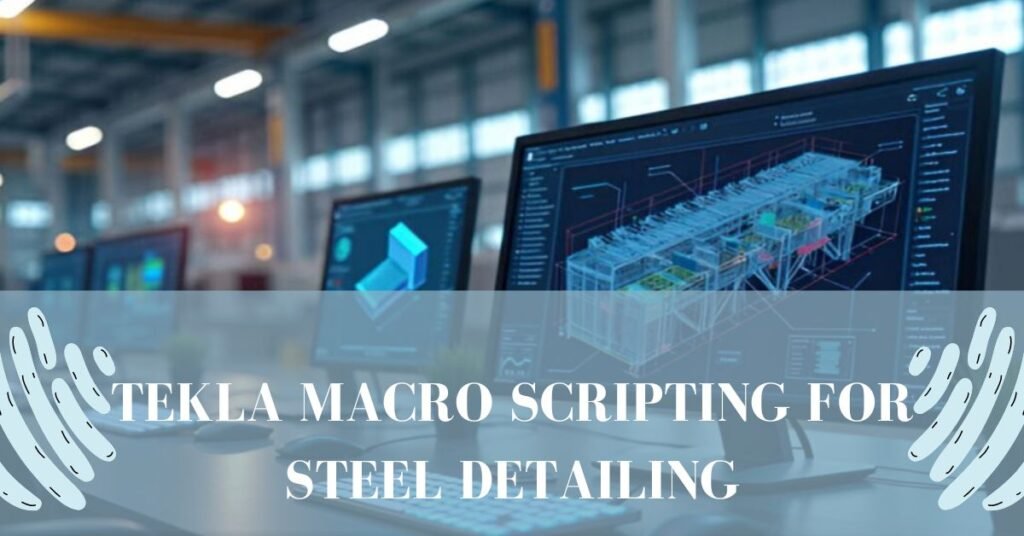In the world of structural engineering and fabrication, steel detailing plays a critical role in transforming design concepts into precise shop drawings and fabrication-ready data. Among the most widely used tools for steel detailing is Tekla Structures, a powerful BIM software that provides advanced modeling, detailing, and documentation capabilities. While Tekla Structures itself is highly capable, many steel detailers and engineering firms are now unlocking an even higher level of productivity through Tekla Macro Scripting.
In this blog, we’ll explore what Tekla Macro Scripting for Steel Detailing is, why it is important for steel detailing, its key benefits, and how detailers can implement it to achieve automation and accuracy in their workflows.
What is Tekla Macro Scripting for Steel Detailing?
Tekla Structures comes with a built-in automation feature known as macros. These macros are essentially small scripts written to perform repetitive tasks inside Tekla’s modeling environment. Instead of manually repeating the same actions over and over, users can record or write a macro to handle the task automatically.
Macros in Tekla are usually written in C# or .NET-based scripting, giving users flexibility and control to create customized workflows. Tekla Macro Scripting can be used for anything from simple modifications, like renaming assemblies, to complex automation, such as creating custom connections, generating reports, or running rule-based checks on models.
Why Tekla Macro Scripting for Steel Detailing
Steel detailing requires a high level of precision and consistency. A small error in a model or drawing can lead to costly mistakes in fabrication or construction. At the same time, detailers often deal with repetitive modeling tasks that consume significant time. This is where macro scripting bridges the gap—by automating routine processes while ensuring accuracy.
In an industry where deadlines are tight and efficiency is key, Tekla Macro Scripting allows detailers to:
- Automate repetitive tasks like numbering, dimensioning, or report generation.
- Standardize detailing practices across multiple projects.
- Reduce human errors that occur during manual operations.
- Free up time to focus on more complex engineering and design tasks.
Key Benefits of Tekla Macro Scripting for Steel Detailing
1. Automation of Repetitive Workflows
Steel detailers often need to create hundreds of assemblies, apply specific naming conventions, or generate identical drawings. Instead of spending hours clicking through menus, a macro can execute these steps instantly, saving valuable project time.
2. Improved Accuracy and Consistency
Macros ensure that the same steps are executed in the same way every time. This eliminates variations that might occur due to manual detailing and helps maintain high-quality deliverables across all projects.
3. Customization to Project Needs
Every steel project is unique, with its own set of rules and requirements. With Tekla Macro Scripting, detailers can customize workflows to match client standards, regional codes, or company preferences—making the detailing process far more adaptable.
4. Enhanced Productivity
Automating mundane tasks allows engineers and detailers to focus on creative and problem-solving aspects of the job. This boosts overall productivity and reduces project turnaround times.
5. Error Reduction
Manual data entry or repetitive clicks are prone to errors. Macros minimize these risks, ensuring that drawings, reports, and fabrication details are accurate and ready for use in production.
Common Applications of Tekla Macro Scripting for Steel Detailing
Here are some practical examples of how Tekla Macro Scripting can be applied in real-world steel detailing projects:
- Automated Numbering: Automatically assign part and assembly numbers based on predefined rules.
- Connection Creation: Generate standardized steel connections with specific bolt sizes, welds, and detailing preferences.
- Batch Drawing Creation: Produce GA drawings, shop drawings, or assembly drawings in bulk with consistent settings.
- Report Generation: Automate material take-off, bolt lists, and cutting lists for fabrication shops.
- Model Checks: Run macros that check for clashes, missing connections, or incorrect part properties.
- Renaming and Reorganizing: Standardize part names, phases, or categories according to company guidelines.
Getting Started with Tekla Macro Scripting for Steel Detailing
If you’re new to Tekla Macro Scripting, here are some steps to help you begin:
1. Learn the Basics of Tekla API
Tekla Structures provides an Open API (Application Programming Interface) that allows developers and detailers to create custom scripts. Familiarity with C# or .NET programming will help you get the most out of macro development.
2. Use the Macro Recorder
For beginners, Tekla offers a Macro Recorder that lets you record actions performed in the software and then replay them as macros. This is a great starting point for automating simple tasks without needing advanced coding skills.
3. Explore Tekla Developer Center
Tekla provides documentation, forums, and sample codes through the Tekla Developer Center. This resource is invaluable for learning how to script macros effectively.
4. Start Small and Scale Up
Begin by automating smaller repetitive tasks—such as renaming objects or creating reports. Once comfortable, you can progress to building more advanced macros that handle complex detailing workflows.
5. Collaborate with BIM Automation Experts
Many companies partner with BIM automation specialists to develop advanced macros tailored to their projects. This can significantly boost detailing efficiency while ensuring high-quality deliverables.
Best Practices for Tekla Macro Scripting
To ensure successful implementation, here are a few best practices:
- Maintain Clean Code: Write scripts that are easy to understand and maintain.
- Test Before Deployment: Always test macros on smaller models before using them on live projects.
- Document Your Scripts: Keep records of what each macro does for future reference and team collaboration.
- Update Regularly: As Tekla releases new versions, ensure your macros are updated for compatibility.
- Focus on ROI: Prioritize scripting tasks that will save the most time and provide the highest return on investment.
The Future of Steel Detailing with Macro Scripting
As the construction industry continues to embrace digital transformation and automation, Tekla Macro Scripting will become an even more essential skill for steel detailers. By combining BIM capabilities with custom automation, detailers can achieve faster project delivery, greater accuracy, and improved collaboration with fabricators and contractors.
The integration of macro scripting with other automation tools, such as parametric modeling and cloud-based collaboration platforms, points toward a future where repetitive manual tasks are virtually eliminated, leaving detailers free to focus on innovation and problem-solving.
Conclusion
Tekla Macro Scripting for Steel Detailing is more than just a time-saving feature—it’s a powerful tool that empowers steel detailers to automate workflows, reduce errors, and deliver consistent, high-quality results. Whether you’re just starting with basic macros or developing advanced custom scripts, the benefits are clear: faster detailing, improved accuracy, and enhanced productivity.
For steel detailing companies aiming to stay competitive, adopting macro scripting is no longer optional—it’s a strategic move toward smarter, more efficient project delivery.
Read more: My Automotive: The Complete Guide to Automotive Bumper Repair





